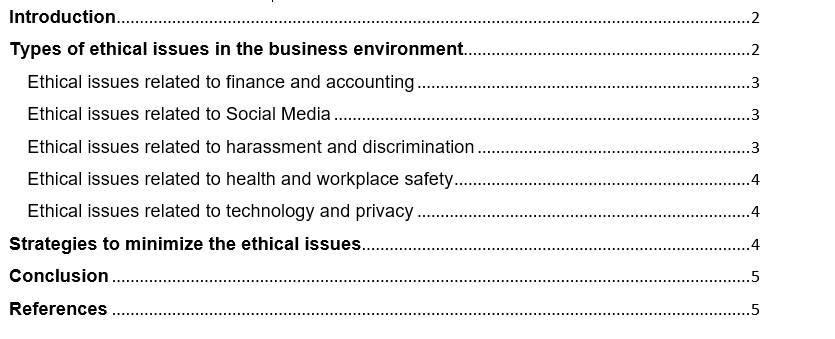Table of Contents
WHAT ARE THE ETHICAL ISSUES FACED BY THE BUSINESS? 3
Types of ethical issues seen in business 5
Health and safety at workplace 8
Forms Of Corruptions Used In Business (Morris, 2011) 8
ABSTRACT
INTRODUCTION
You have given too many unnecessary sub-headings which are not required
Introduction

WHAT ARE THE ETHICAL ISSUES FACED BY THE BUSINESS?
The heading and the content below, does not match.
Types of ethical issues seen in business – again the types ? how many time you will explain the types of ethical issues?
Disruption of business ethics can affect the position of the business in various ways. It takes a lot of time to build a business with a proper benchmark and reputation among the other competitors and across the globe. The head of the company may face ethical issues at various levels of individual, organizational, and globally. unethical business behaviors may damage productivity, and lose standards, affect society's moral values, cause environmental degradation, and might result in a lack of trust. Kaur (2017) has identified ethical issues like legal liabilities under prevailing law, establishing safety at the workplace, avoiding child labor, controlling gender and cultural/racial/color discrimination bribery, cybercrimes, overbilling, privacy threats, and disclosures at social networking. Frauds, misleading, fake reimbursements, etc. can also be observed in different businesses and management. (Nuseir & Ghandour, 2019)
There are fundamental issues which represent trust, integrity and treating the customer fairly), Diversity issues which represent recruitment and management of business teams which are diverse in nationality, gender, culture and color, decision-making issues and compliance and governance issue. Bernstein (2016) categorized current ethical issues into five categories: social networking, surveillance and privacy, transparency, child labor, and environmental protection
Ethical issues related to account and finance
Social Media issues
Harassment and discrimination
Some research also shows that Past reinforcement of the ethical decision influence the behavior.
Discrimination and harassment became very common in the workplace. It is caused by the disruption in .values youth and community work. (George, 2011). Florida Tech (2017) has mentioned that according to a report from the Equal Employment Opportunity Commission (EEOC), harassment and discrimination cost US companies $372.1 million as penalties in 2013. Laws are made, and regulations have been issued by governments of almost all countries whereas International Labour Organization (ILO, 2017) is observing and monitoring at the global level to check and control discriminations and harassment but still in actual practice. Some values which need to be followed to maintain these types of unprofessional ways of criticizing are, Respect for basics human rights- eq justice, freedom, Respect for individuals and rights and self-determination, Respect for different cultures and religions in society, A commitment to empowerment and participatory democracy, Collaborative working relationships and collective actions and An acknowledgment that all relationships and activities with young people and adults are based on their consent. (Nuseir & Ghandour, 2019)
Technology/privacy
Health and safety at workplace
Forms Of Corruptions Used In Business (Morris, 2011)
judiciary, the local government, the police, customs agents, building inspectors, etc.) (Morris,
2011). second is the Nature of the transaction which involves It draws a distinction between “bribery” and “extortion”. In bribery, societal interests use extra-legal payments or bribes to influence the content of state policy or its implementation. Extortion, by contrast, involves the use and abuse of state power by public officials to demand extra-legal payments or rents in return for providing a legitimate or illegitimate service. Third is the systemic framework which includes Extortion, by contrast, involves the use and abuse of state power by public officials to demand extra-legal payments or rents in return for providing a legitimate or illegitimate service. And last is motivate or purpose which says “based on the motives, purpose or outcome of the corrupt act. The range of course, can be rather extensive. Does the corrupt act” (Morris, 2011)
MANAGEMENT
Mitigation OF THE ETHICAL ISSUES
Training Program
Whistle blower
CONCLUSION
could be managed, this research also shows the various forms of ethics and issues which are
linked with those ethics and norms. But the presence of various people with different behavior
some extent by following the lessons to minimize corruption within the organization which is
discussed in this research. The management options and strategies are compulsory to cope with various types of ethical issues for which the basic need is clear understanding of major issues and their potential losses and putting in all wisdom by business managers. Social Network/Media disclosure of the company’s secrets and cybercrimes by corporate employees and the managers, Misleading accounts’ and financial analysis, frauds, overbilling, bribery, fake reimbursements and overpricing, etc,Misuse and misappropriation and careless utilization of company assets, Health and safety at the workplace, more extended working hours, child labor, cultural and gender discrimination, and sexual harassment, Misleading performance appraisal and evaluation of employees and project work
References
GORTA, A. (1998). Minimising corruption: Applying lessons from the crime. Crime, Law & Social Change, 67-87.
Hayibor, S. (2017) ‘Is fair treatment enough? Augmenting the fairness-based perspective on stakeholder behaviour’, Journal of Business Ethics, Vol. 140, No. 1, pp.43–64 [online] https://doi.org/10.1007/s10551-015-2665-6
Nuseir, M., & Ghandour, A. (2019). Ethical issues in modern business management. International Journal Of Procurement Management, 12(5), 592. doi: 10.1504/ijpm.2019.102153
Scott J. Vitell, E. R. (2006). The Impact of Corporate Ethical codes. Journal of Business Ethics (2006), 31-43.
